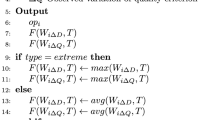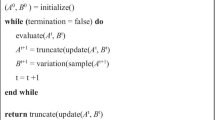Abstract
This paper investigates the ability of Multiobjective Evolutionary Algorithms (MOEAs), namely the Non-dominated Sorting Genetic Algorithm II (NSGA-II), Pareto Envelope-based Selection Algorithm (PESA) and Strength Pareto Evolutionary Algorithm 2 (SPEA2), for solving complex portfolio optimization problems. The portfolio optimization problem is a typical bi-objective optimization problem with objectives the reward that should be maximized and the risk that should be minimized. While reward is commonly measured by the portfolio’s expected return, various risk measures have been proposed that try to better reflect a portfolio’s riskiness or to simplify the problem to be solved with exact optimization techniques efficiently. However, some risk measures generate additional complexities, since they are non-convex, non-differentiable functions. In addition, constraints imposed by the practitioners introduce further difficulties since they transform the search space into a non-convex region. The results show that MOEAs, in general, are efficient and reliable strategies for this kind of problems, and their performance is independent of the risk function used.
Similar content being viewed by others
References
Acerbi C, Tasche D (2002) Expected shortfall: a natural coherent alternative to value at risk. Economic Notes by Banca Monte dei Paschi di Siena spA 31(2): 379–388
Anagnostopoulos KP, Chatzoglou PD, Katsavounis S (2004) A reactive Greedy Randomized Adaptive Search Procedure for a mixed integer portfolio optimization problem. In: Chatzoglou PD (eds) Proceedings of the 2nd international conference on accounting and finance in transition (CD)
Armananzas R, Lozano JA (2005) A multiobjective approach to the portfolio optimization problem. In: IEEE congress on evolutionary computation, vol 2, pp 1388–1395
Artzner P, Delbaen F, Eber JM, Heath D (1999) Coherent measures of risk. Math Finance 9(3): 203–228
Benati S, Rizzi R (2007) A mixed integer linear programming formulation of the optimal mean/Value-at-Risk portfolio problem. Eur J Oper Res 176: 423–434
Bonissone PP, Subbu R, Eklund N, Kiehl TR (2006) Evolutionary Algorithms + Domain Knowledge = Real-World Evolutionary Computation. IEEE Trans Evol Comput 10(3): 256–280
Branke J, Scheckenbach B, Stein M, Deb K, Schmeck H (2009) Portfolio optimization with an envelope-based multi-objective evolutionary algorithm. Eur J Oper Res 199(3): 684–693
Chang TJ, Meade N, Beasley JE, Sharaiha YM (2000) Heuristics for cardinality constrained portfolio optimization. Comput Oper Res 27: 1271–1302
Chiam SC, Tan KC, Mamum AAl (2008) Evolutionary multi-objective portfolio optimization in practical context. Int J Autom Comput 5(1): 67–80
Coello CAC (2000) An updated survey of GA-based multiobjective optimization techniques. ACM Comput Surv 32(2): 109–143
Coello CAC, Lamont GB, Van Veldhuizen DA (2007) Evolutionary algorithms for solving multi-objective problems, 2nd edn. Springer, Berlin
Corne DW, Knowles JD, Oates MJ (2000) The pareto envelope-based selection algorithm for multiobjective optimization. In: Schoenauer M, Deb K, Rudolph G, Yao X, Lutton E, Merelo JJ, Schwefel H-P (eds) Proceedings of the parallel problem solving from nature. VI Conference, Paris, France. Springer. Lecture Notes in Computer Science, vol 1917, pp 839–848
Crama Y, Schyns M (2003) Simulated annealing for complex portfolio selection problems. Eur J Oper Res 150: 546–571
Deb K, Pratap A, Agarwal S, Meyarivan T (2002) A fast and elitist multiobjective genetic algorithm: NSGA-II. IEEE Trans Evol Comput 6(2): 182–197
Diosan L (2005) A multi-objective evolutionary approach to the portfolio optimization problem. In: Proceedings of the international conference on computational intelligence for modelling, control and automation, pp 183–188
Dueck G, Winker P (1992) New concepts and algorithms for portfolio choice. App Stoch Models Data Anal 8: 159–178
Gaivoronski AA, Pflug G (2004) Value at risk in portfolio optimization: properties and computational approach. J Risk 7: 1–31
Gilli M, Kellezi E (2002) A global optimization heuristic for portfolio choice with VaR and expected shortfall. In: Kontoghiorghes EJ, Rustem B, Siokos S (eds) Computational methods in decision-making, economics and finance, Applied Optimization Series. Kluwer Academic Publishers, Dordrecht, , pp 167–183
Gilli M, Kellezi E, Hysi H (2006) A data-driven optimization heuristic for downside risk minimization. J Risk 8(3): 1–18
Jobst NJ, Horniman MD, Lucas CA, Mitra G (2001) Computational aspects of alternative portfolio selection models in the presence of discrete asset choice constraints. Quant Finance 1: 1–13
Kellerer H, Maringer DG (2003) Optimization of cardinality constrained portfolios with a hybrid local search algorithm. OR Spectrum 25(4): 481–495
Knowles J, Thiele L, Zitzler E (2006) A tutorial on the performance assessment of stochastic multiobjective optimizers. TIK Report 214, Computer Engineering and Networks Laboratory (TIK), ETH Zurich
Krink T, Paterlini S (2009) Multiobjective optimization using differential evolution for real-world portfolio optimization. Comput Manage Sci. doi:10.1007/s10287-009-0107-6
Laumanns M, Zitzler E, Thiele L (2000) A unified model for multi-objective evolutionary algorithms with elitism. In: Proceedings of the 2000 congress on evolutionary computation. IEEE Press, Piscataway, NJ, pp 46–53
Lin CC, Liu YT (2008) Genetic algorithms for portfolio selection problems with minimum transaction lots. Eur J Oper Res 185: 393–404
Mansini R, Ogryczak W, Speranza GM (2003) LP solvable models for portfolio optimization: a classification and computational comparison. IMA J Manage Math 14: 187–220
Markowitz HM (1952) Portfolio selection. J Finance 7: 77–91
Markowitz HM (1990) Portfolio selection, efficient diversification of investments. Blackwell, Cambridge MA and Oxford UK
Mitra G, Kriakis T, Lucas C, Pirbhai M (2003) A review of portfolio planning: models and systems. In: Stachell SE, Scowcroft A (eds) Advances in portfolio construction and implementation. Butterworth-Heinemann, Oxford
Ong CS, Huang JJ, Tzeng GH (2005) A novel hybrid model for portfolio selection. Appl Math Comput 169: 1195–1210
Rockafellar RT, Uryasev S (2000) Optimization of conditional value-at-risk. J Risk 2(3): 21–41
Schaerf A (2002) Local search techniques for constrained portfolio selection problems. Comput Econ 20(3): 177–190
Streichert F, Ulmer H, Zell A (2003) Evolutionary algorithms and the cardinality constrained portfolio optimization problem. In: Selected papers of the international conference on operations research, pp 253–260
Subbu R, Bonissone P, Eklund N, Bollapragada S, Chalermkraivuth K (2005) Multiobjective financial portfolio design: A hybrid evolutionary approach. In: IEEE congress on evolutionary computation, vol 2, pp 1722–1729
Zitzler E, Laumanns M, Thiele L (2001) SPEA2: Improving the Strength Pareto Evolutionary Algorithm. TIK-103. Department of Electrical Engineering, Swiss Federal Institute of Technology, Zurich, Switzerland
Zitzler E, Thiele L (1999) Multiobjective evolutionary algorithms: a comparative case study and the strength pareto approach. IEEE Trans Evol Comput 3(4): 257–271
Zitzler E, Thiele L, Laumanns M, Fonseca CM, Grunertda Fonseca V (2003) Performance assessment of multiobjective optimizers: an analysis and review. IEEE Trans Evol Comput 7: 117–132
Author information
Authors and Affiliations
Corresponding author
Rights and permissions
About this article
Cite this article
Anagnostopoulos, K.P., Mamanis, G. Multiobjective evolutionary algorithms for complex portfolio optimization problems. Comput Manag Sci 8, 259–279 (2011). https://doi.org/10.1007/s10287-009-0113-8
Received:
Accepted:
Published:
Issue Date:
DOI: https://doi.org/10.1007/s10287-009-0113-8




